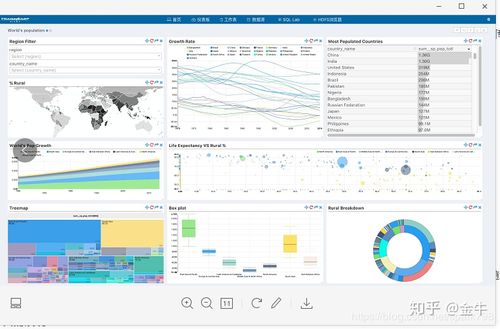大数据常用的处理工具有哪些
Title: Exploring Leading Tools for Big Data Processing and Development
In the dynamic landscape of big data processing, an array of tools have emerged to cater to diverse needs, spanning from data ingestion to analysis and visualization. Let's delve into some of the leading tools in this domain:
Apache Hadoop:
Overview:
Apache Hadoop is a pioneer in the realm of big data processing. It provides a distributed storage and processing framework, enabling the processing of large datasets across clusters of computers.Key Components:
1.
Hadoop Distributed File System (HDFS):
A distributed file system designed to store vast amounts of data across multiple machines.2.
MapReduce:
A programming model for processing and generating large datasets in parallel across a Hadoop cluster.3.
YARN (Yet Another Resource Negotiator):
A resource management layer for scheduling jobs and managing resources in Hadoop.Use Cases:
Hadoop is suitable for batch processing of large datasets, especially in scenarios where data locality and fault tolerance are crucial.Guidance:
While Hadoop remains a stalwart in the big data ecosystem, its batch processing model may not be ideal for realtime analytics or interactive querying. Consider alternative solutions for such use cases.Apache Spark:
Overview:
Apache Spark is an opensource, distributed computing system that provides an interface for programming entire clusters with implicit data parallelism and fault tolerance.Key Features:
1.
InMemory Processing:
Spark keeps data in memory, which enhances processing speed significantly compared to diskbased systems like Hadoop.2.
Rich APIs:
Spark offers APIs in Java, Scala, Python, and R, making it accessible to a wide range of developers.3.
Unified Processing Engine:
Spark supports diverse workloads including batch processing, realtime streaming, machine learning, and interactive SQL queries.Use Cases:
Spark is wellsuited for iterative algorithms, interactive data analysis, and realtime processing, making it ideal for applications requiring lowlatency responses.Guidance:
Consider Spark for use cases that demand realtime analytics, iterative processing, or a unified platform for various data processing tasks.Apache Flink:
Overview:
Apache Flink is a powerful stream processing framework with sophisticated support for batch processing.Key Features:
1.
Low Latency:
Flink offers lowlatency processing for realtime analytics, making it suitable for applications requiring near realtime responses.2.
ExactlyOnce Semantics:
Flink provides support for exactlyonce semantics, ensuring accurate processing of data even in the presence of failures.3.
Dynamic Scaling:
Flink dynamically adjusts resources based on workload requirements, optimizing resource utilization.
Use Cases:
Flink is ideal for scenarios requiring both batch and stream processing, such as fraud detection, realtime monitoring, and recommendation systems.Guidance:
Evaluate Flink for applications demanding lowlatency stream processing and precise data semantics, especially when dealing with highthroughput data streams.Apache Kafka:
Overview:
Apache Kafka is a distributed streaming platform that is commonly used for building realtime data pipelines and streaming applications.Key Features:
1.
Distributed Messaging:
Kafka provides a distributed messaging system for publishing and subscribing to streams of records.2.
Scalability:
Kafka scales horizontally to handle high throughput and large volumes of data with ease.3.
Fault Tolerance:
Kafka replicates data across multiple brokers, ensuring fault tolerance and high availability.Use Cases:
Kafka is wellsuited for building realtime data pipelines, log aggregation, event sourcing, and stream processing.Guidance:
Incorporate Kafka into your architecture for building scalable, faulttolerant streaming applications and data pipelines.Conclusion:
The landscape of big data processing tools is vast and continually evolving. Selecting the right tools depends on the specific requirements of your project, such as processing speed, data volume, latency, and fault tolerance. Evaluate the strengths and weaknesses of each tool in the context of your use case to make informed decisions. Additionally, consider factors like community support, ecosystem integration, and ease of use when choosing tools for your big data projects.
This HTML structure should make it easier for you to incorporate into your project or presentation. Let me know if you need any further assistance!
标签: 大数据常用的开发工具 大数据开发用什么工具 大数据应用的开发流程有哪些步骤
相关文章
-
景顺成长,探索中国城市化进程中的绿色发展之路详细阅读

在21世纪的今天,城市化已成为全球范围内不可逆转的趋势,中国,作为世界上人口最多的国家,其城市化进程尤为引人注目,随着经济的快速发展,城市化带来的问题...
2025-10-01 199
-
深度解析,股票000777中核科技的投资价值与未来展望详细阅读

在当今的投资市场中,股票投资无疑是一个热门话题,而在众多股票中,股票代码为000777的中核科技因其独特的行业地位和发展潜力,吸引了众多投资者的目光,...
2025-09-30 241
-
深圳证券交易所交易规则,投资市场的指南针详细阅读

亲爱的读者,想象一下,你正站在一个繁忙的十字路口,四周是熙熙攘攘的人群和川流不息的车辆,每个人都在按照交通规则行事,红灯停,绿灯行,黄灯亮起时,大家会...
2025-09-30 201
-
基金202005,揭秘投资背后的逻辑与策略详细阅读

在投资的世界里,基金是一种备受瞩目的投资工具,它以其多样化的投资组合、专业的管理团队和相对稳定的收益吸引了众多投资者的目光,我们将深入探讨基金2020...
2025-09-30 194
-
探索中国平安行销,策略、实践与未来趋势详细阅读

在当今竞争激烈的市场环境中,行销策略对于企业的成功至关重要,中国平安,作为中国领先的金融服务集团,其行销策略不仅在国内市场上取得了显著成效,也为全球行...
2025-09-29 201
-
深入解析数码视讯股票,投资价值与市场前景详细阅读

在当今数字化时代,数码视讯行业作为信息技术领域的重要组成部分,正逐渐成为投资者关注的焦点,本文将深入探讨数码视讯股票的投资价值与市场前景,帮助投资者更...
2025-09-29 242
-
悦康药业,创新与责任并重,引领健康未来详细阅读

在当今这个快节奏、高压力的社会中,健康成为了人们越来越关注的话题,而在医药行业中,有这样一家企业,它以创新为驱动,以责任为担当,致力于提供高质量的药品...
2025-09-29 192
-
深度解析,定向增发股票背后的资本游戏与投资策略详细阅读

在资本市场的棋盘上,股票的每一次变动都牵动着投资者的神经,定向增发作为一种特殊的融资方式,因其能够为上市公司带来资金的同时,也为投资者提供了新的投资机...
2025-09-29 196
